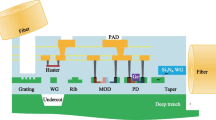Abstract
Two major research areas including assistive devices and Interconnect modelling for VLSI design are focused by Dr. Madhav Rao in IIIT-Bangalore. 3D interconnect is considered a solution to stack different functionalities on a system on chip (SoC), in a view to achieve faster computations and accommodate higher load on the chip. The 3D interconnects offers the luxury for the designers to not worry on the wiring and instead optimize the design independently. The research attempts to model 3D wirings using novel composite materials including Carbon nanotubes with Copper, instead of traditional wiring material to facilitate SoC performance with better interconnect design. Assistive robotic devices development to a growing uncared population is considered highly beneficial. In IIIT-Bangalore, Dr. Madhav Rao along with his students are working on developing assistive devices for clinical trials, and building devices for surgical purposes. The assistive robotics research covers range of device development aiding in upper limb movement, regular lower limb ankle actuation to overcome deep vein thrombosis, and ventricular assistance to promote blood flow for weak heart.


Similar content being viewed by others
References
Awano Y, Sato S, Nihei M, Sakai T, Ohno Y, Mizutani T (2010) Carbon nanotubes for vlsi: interconnect and transistor applications. Proc IEEE 98(12):2015–2031
Alam N, Kureshi A, Hasan M, Arslan T (2009) Carbon nanotube interconnects for low-power high-speed applications. In: IEEE international symposium on circuits and systems 2009. ISCAS 2009, pp 2273–2276, May
Ramm P, Wolf MJ, Klumpp A, Wieland R, Michel B, Reichi H (2008) Through silicon via processes and reliability for wafer-level 3d system integration. In: Proceedings of the electronic components and technology conference, pp 841–846
Kim DY, Kim J, Prabakar M, Jung Y (2016) Design of smart portable rehabilitation exoskeletal device for upper limb. In: 2016 32nd southern biomedical engineering conference (SBEC), March 2016, pp 134–134
Tripanpitak K, Tarvainen TVJ, Snmezisik I, Wu J, Yu W (2017) Design a soft assistive device for elbow movement training in peripheral nerve injuries. In: 2017 IEEE international conference on robotics and biomimetics (ROBIO), Dec 2017, pp 544–548
Song R, Tong K, Hu X, Li L (2008) Assistive control system using continuous myoelectric signal in robot-aided arm training for patients after stroke. IEEE Trans Neural Syst Rehabilit Eng 16(4):371–379
Yonezawa T, Nomura K, Onodera T, Ichimura S, Mizoguchi H, Takemura H (2015) Evaluation of venous return in lower limb by passive ankle exercise performed by PHARAD. In: 2015 37th annual international conference of the IEEE engineering in medicine and biology society (EMBC), Milan, 2015, pp 3582–3585
Rachakorakit M, Charoensuk W (2017) Development of LeHab robot for human lower limb movement rehabilitation. In: 2017 10th biomedical engineering international conference (BMEiCON), Hokkaido, 2017, pp 1–5
Sen A et al (2016) Mechanical circulatory assist devices: a primer for critical care and emergency physicians. Crit Care 20(1):153
Patel S, Nicholson L, Cassidy CJ, Wong KY-K (2016) Left ventricular assist device: a bridge to transplant or destination therapy? Postgrad Med J 92(1087):271–281
Harris P, Kuppurao L (2012) Ventricular assist devices. Contin Educ Anaesth Crit Care Pain 12(3):145–151
Acknowledgements
The support from Visvesvaraya Ph.D. scheme enabled to initiate work independently in the area of Assistive devices and later extend by submitting a comprehensive proposal to different funding agencies. The work on 3D interconnects was made visible due to the conference travel support which was possible only due to Visvesvaraya Ph.D. Scheme. The scheme has also given more opportunities to collaborate with colleagues and peers across different domain in different institutes in India, and possibly abroad in the future.
Author information
Authors and Affiliations
Corresponding author
Rights and permissions
About this article
Cite this article
Rao, M. Research highlights. CSIT 7, 205–208 (2019). https://doi.org/10.1007/s40012-019-00237-8
Received:
Accepted:
Published:
Issue Date:
DOI: https://doi.org/10.1007/s40012-019-00237-8




